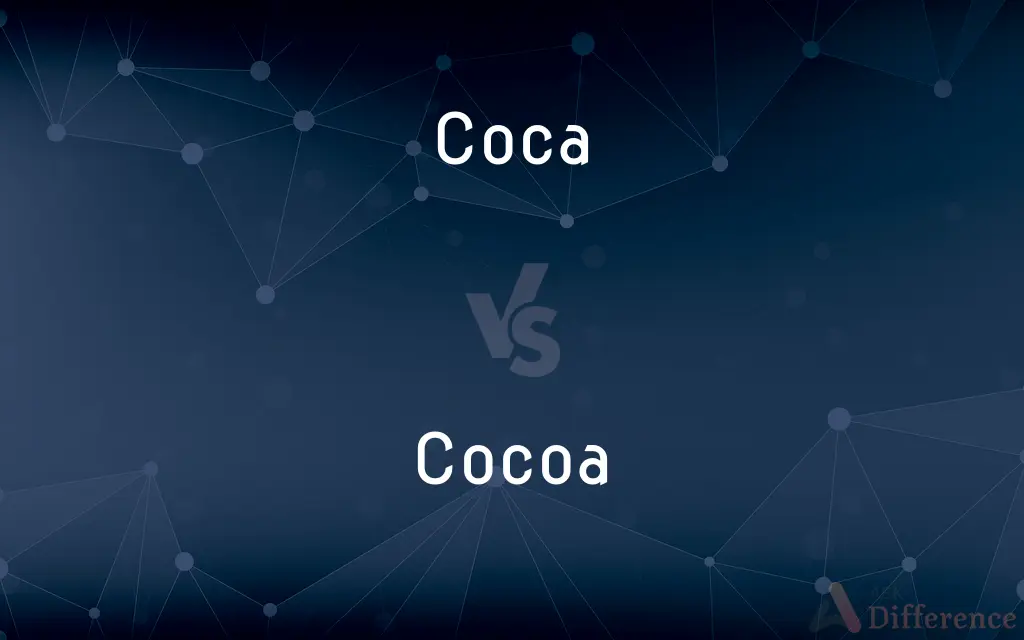Coca vs. Cocoa — What's the Difference?
By Tayyaba Rehman — Updated on November 2, 2023
Coca refers to a plant known for its stimulant properties, whereas cocoa is a powder made from roasted cacao beans, used in chocolate.

Difference Between Coca and Cocoa
Table of Contents
ADVERTISEMENT
Key Differences
Coca and cocoa are often confused due to their similar spelling, but they refer to distinctly different things. Coca, scientifically known as Erythroxylum coca, is a plant native to northwestern South America. The leaves of the coca plant contain alkaloids which are the basis for cocaine and have been chewed for centuries for their stimulative effects.
Cocoa, on the other hand, is a term that refers to the processed form of the seeds of the Theobroma cacao tree. These seeds are used to produce cocoa powder and chocolate. Unlike coca, cocoa is known for its role in the food industry and is celebrated for its rich flavor and antioxidant properties.
While coca is a source of the potent stimulant cocaine, cocoa is the main ingredient in chocolate and is consumed worldwide in various forms. Coca is subject to stringent regulation due to its association with cocaine, whereas cocoa is widely cultivated for its commercial value.
Coca plays a significant role in the Andean culture and has a controversial standing globally due to its derivative, cocaine. Cocoa is culturally significant as well, with its roots in Mesoamerica and a history of being a luxury good.
Despite their phonetic resemblance, coca is primarily associated with traditional uses and controversies over drug production, whereas cocoa is universally recognized for its culinary applications, particularly in sweets and desserts.
ADVERTISEMENT
Comparison Chart
Origin
Plant indigenous to South America, known for its psychoactive alkaloids.
Seeds from the cacao tree, used for making chocolate and related products.
Primary Use
Chewing the leaves for energy or as a raw material for cocaine.
Processed for culinary uses, notably in desserts and beverages.
Legal Status
Controlled substance due to cocaine; cultivation is legal in some countries.
Freely cultivated and traded globally; not a controlled substance.
Cultural Significance
Historically used in Andean religious ceremonies and as a traditional medicine.
A major ingredient in sweets, symbolizing indulgence and comfort in many cultures.
Health Impact
Stimulant properties that can lead to serious health issues if misused.
Contains antioxidants and can be part of a healthy diet in moderation.
Compare with Definitions
Coca
The source plant for cocaine, a powerful illegal stimulant.
Coca cultivation is heavily monitored due to its potential to be processed into cocaine.
Cocoa
A shade of brown that resembles the color of cocoa powder.
The walls were painted a rich cocoa, creating a cozy atmosphere.
Coca
Leaves of the coca plant, traditionally used to relieve altitude sickness.
He carried a pouch of coca leaves to help him hike the mountainous terrain.
Cocoa
Powder made from roasted, ground cacao beans, used for making chocolate.
She added a spoonful of cocoa to the milk to make hot chocolate.
Coca
A crop that is legal in certain countries for traditional and medicinal uses.
The farmer was granted a license to grow coca for the local market.
Cocoa
A warm beverage made by mixing cocoa powder with milk or water.
It's chilly outside, so I made a mug of cocoa to warm up.
Coca
A plant with significant cultural importance in Andean societies.
Coca plays a central role in the spiritual practices of many Andean tribes.
Cocoa
A key ingredient in chocolate bars and confectioneries.
The cocoa content determines the bitterness of the chocolate.
Coca
A South American plant with leaves that contain stimulant alkaloids.
The indigenous people of the Andes have been chewing coca leaves for centuries.
Cocoa
A flavoring obtained from cacao seeds, used in baking and desserts.
The recipe calls for two tablespoons of cocoa for the cake.
Coca
Coca is any of the four cultivated plants in the family Erythroxylaceae, native to western South America. Coca is known for its psychoactive alkaloid, cocaine.
Cocoa
A powder made from cacao seeds after they have been fermented, roasted, shelled, ground, and freed of most of their fat.
Coca
A tropical American shrub grown for its leaves, which are the source of cocaine.
Cocoa
See hot chocolate.
Coca
Any of certain Andean evergreen shrubs or small trees of the genus Erythroxylum, especially E. coca, whose leaves contain cocaine and other alkaloids.
Cocoa
A moderate brown to reddish brown.
Coca
The dried leaves of such a plant, chewed by people of the Andes for a stimulating effect and also used for extraction of cocaine and other alkaloids.
Cocoa
The dried and partially fermented fatty seeds of the cacao tree from which chocolate is made.
Coca
Any of the four cultivated plants which belong to the family Erythroxylaceae, native to western South America.
Cocoa
An unsweetened brown powder made from roasted, ground cocoa beans, used in making chocolate, and in cooking.
Coca
The dried leaf of one of these plants, the South American shrub (Erythroxylum coca), widely cultivated in Andean countries, which is the source of cocaine.
Cocoa
(uncountable) A hot drink made with milk, cocoa powder, and sugar.
Do you like cocoa?
Coca
A pastry typically made and consumed in the Catalan-speaking areas.
Cocoa
(countable) A serving of this drink.
I like to watch TV with a cocoa.
Coca
The dried leaf of a South American shrub (Erythroxylon Coca). In med., called Erythroxylon.
Cocoa
A light to medium brown colour.
Coca
A South American shrub whose leaves are chewed by natives of the Andes; a source of cocaine
Cocoa
Alternative spelling of coco.
Coca
United States comedienne who starred in early television shows with Sid Caesar (1908-2001)
Cocoa
Of a light to medium brown colour, like that of cocoa powder.
Coca
Dried leaves of the coca plant (and related plants that also contain cocaine); chewed by Andean people for their simulating effect
Cocoa
A tall palm tree producing the cocoanut (Cocos nucifera) as its fruit. It grows in nearly all tropical countries, attaining a height of sixty or eighty feet. The trunk is without branches, and has a tuft of leaves at the top, each being fifteen or twenty feet in length, and at the base of these the nuts hang in clusters; the cocoanut tree. It is widely planted throughout the tropics, and in some locations as an ornamental tree.
Cocoa
A preparation made from the seeds of the chocolate tree, and used in making, a beverage; also the beverage made from cocoa or cocoa shells.
Cocoa
A beverage made from cocoa powder and milk and sugar; usually drunk hot
Cocoa
Powder of ground roasted cocao beans with most of the fat removed
Common Curiosities
Can you eat coca leaves?
Yes, in regions where it's legal, coca leaves can be chewed or brewed as tea.
Where do cocoa beans come from?
Cocoa beans are the seeds of the cacao tree, primarily grown in tropical regions.
Are coca and cocoa spelled the same in all languages?
No, the spelling can differ depending on the language.
What is cocoa?
Cocoa is a powder made from roasted and ground cacao beans, used primarily in chocolate products.
Is cocoa good for your health?
In moderation, cocoa has antioxidants and can be part of a healthy diet.
Is it legal to grow coca plants?
It depends on the country's laws; in some countries, it's legal for traditional uses.
What is coca?
Coca is a plant native to South America with leaves that contain stimulating alkaloids.
Is coca the same as cocaine?
No, coca is the plant, while cocaine is a concentrated, illegal drug derived from the leaves.
Do coca and cocoa taste the same?
No, they have very different flavors and uses.
How does the cultivation of coca and cocoa impact the environment?
Both can have environmental impacts, but methods like shade-grown cocoa can be more sustainable.
Can coca leaves be used in cooking?
In regions where they are legal, coca leaves may be used in traditional dishes.
What's the economic importance of coca and cocoa?
Coca is economically important in certain regions for legal uses, while cocoa is a significant global commodity in the food industry.
Can you make chocolate with coca leaves?
No, chocolate is made with cocoa, not coca leaves.
Is cocoa used in any products besides food?
Yes, cocoa butter, derived from the beans, is used in cosmetics and skincare.
Are there any rituals associated with coca or cocoa?
Yes, coca has traditional Andean rituals, while cocoa is often associated with social and holiday customs.
Share Your Discovery

Previous Comparison
Frustrated vs. Disappointed
Next Comparison
Furor vs. FuroreAuthor Spotlight
Written by
Tayyaba RehmanTayyaba Rehman is a distinguished writer, currently serving as a primary contributor to askdifference.com. As a researcher in semantics and etymology, Tayyaba's passion for the complexity of languages and their distinctions has found a perfect home on the platform. Tayyaba delves into the intricacies of language, distinguishing between commonly confused words and phrases, thereby providing clarity for readers worldwide.















































